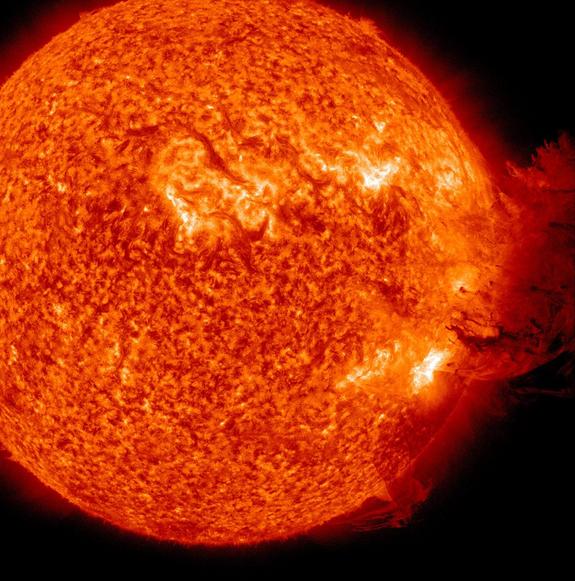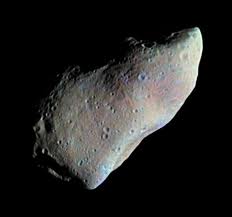 Jun 25, 2011; 5:02 AM ET
Jun 25, 2011; 5:02 AM ET
On Monday, around 1:00 PM EDT, Asteroid 2011 MD is expected to pass less than 8,000 miles from Earth. The asteroid is expected to be able to be viewed in parts of the Southern Hemisphere, including some of Antarctica, Australia, New Zealand and South Africa.
The asteroid was first spotted by the Lincoln Near-Earth Research Project on June 22.
Experts says there is no chance that the asteroid will hit Earth on this approach, and almost no risk at its next close approach in 2022. If the asteroid did strike, it would probably explode in the upper atmosphere and would harmless to us here on the surface of Earth.
This may be the largest known asteroid to approach this close to Earth, but we have only been monitoring close asteroid passes since the the 1990’s. Without a doubt, asteroids as large or larger have passed this close or closer before then.
The asteroid will be very hard to observe after its closest approach, since it’s departing more or less toward the Sun.
Mayan Calendar: 2012 Event and Beyond- Is it all True Series #188
 The New Mexico UFO and Paranormal Forum enjoyed a visit from Eugene Duran. He presented his fascinating view on what connects 2012 and the Mayan Calendar. The stars and the galactic alignment might very well be the key to all the hoopla surrounding this now quite famous year. As Eugene demonstrated, our solar system vacillates right of perpendicular to the Milky Way, but at a point we line up with the flat plane of the center of the Milky Way. This event is considered the end and a beginning of a long cycle and is part of the beginning and end of several of the Mayan calendars. These cycles definitely signal some very big change to our world. This may expose us to the very center of our existence. Chances are there is a powerful force that holds and creates the shape of the great Milky Way.
The New Mexico UFO and Paranormal Forum enjoyed a visit from Eugene Duran. He presented his fascinating view on what connects 2012 and the Mayan Calendar. The stars and the galactic alignment might very well be the key to all the hoopla surrounding this now quite famous year. As Eugene demonstrated, our solar system vacillates right of perpendicular to the Milky Way, but at a point we line up with the flat plane of the center of the Milky Way. This event is considered the end and a beginning of a long cycle and is part of the beginning and end of several of the Mayan calendars. These cycles definitely signal some very big change to our world. This may expose us to the very center of our existence. Chances are there is a powerful force that holds and creates the shape of the great Milky Way.
Now did the Mayans know the great secret that when all mankind and all other living beasts are exposed to this cosmic beam, all life comes to an end? Or the other possibility is this blast from the center of the Milky Way is a re-evolution beam, that changes our cell frequency and thus a nearly instant change from man 2012 to a Super Man 2112 – a 100-year leap to the New Earth and New Human.
Did the Mayans know this and pack up and leave this planet or go deep underground where they still exist in a beautiful sub-terrestrial world? The Mayans may have been the original residents of Mars and as Mars started to over-heat, the Mayans went underground to survive. And after hundreds of years under Mars, they then came to the beautiful blue planet Earth and started over and built the wonderful Pyramids. This amazing culture that developed always had an eye on the stars, because they knew time had powerful cycles. They did everything they could to understand them; they even hoped that human sacrifice would change the natural cycles of this powerful Universe. So I know there is nothing we can do, short of blasting off at the speed of light and hope we can stay ahead of the re-evolution beam. Or we can wait it out, enjoy the possibilities and not fear it, but truly embrace the new us.
Thanks Eugene for sharing- it activates our inner self.
Sleep tight – and bathe in the wonder of tomorrow.
MWiz
Coronal mass ejection as viewed by the Solar Dynamics Observatory on June 7, 2011. — Amazing and a little Scary
The sun unleashed a massive solar storm today (June 7) in a dazzling eruption that kicked up a vast cloud of magnetic plasma that appeared to rain back down over half of the sun’s entire surface, NASA scientists say.
The solar storm hit its peak at about 2:41 a.m. EDT (0641 GMT), but the actual flare extended over a three-hour period, said C. Alex Young, a solar astrophysicist at NASA’s Goddard Space Flight Center who runs a website called The Sun Today, in a video describing the event.
“The sun produced a quite spectacular prominence eruption that had a solar flare and high-energy particles associated with it, but I’ve just never seen material released like this before,” Young said. “It looks like somebody just kicked a giant clod of dirt into the air and then it fell back down.” [Video: See the sun’s June 7 solar flare and eruption]
What is Quantum Jumping? www.QuantumJumping.comDiscover Why Thousands of People are “Jumping” to Change Their LifeAds by Google
NASA’s Solar Dynamics Observatory spacecraft caught high-definition video of the flare in different wavelengths. The event registered as a Class M-2 solar flare, which is a medium-class sun storm that should not pose a danger to satellites or infrastructure on Earth.
An alert by the NOAA-operated Space Weather Prediction Center stated that the solar flare could create a strong geomagnetic storm on Wednesday (June 9) from the event’s coronal mass ejection (CME), an explosion of charged particles triggered by the flare. Geomagnetic storms can lead to stronger than normal displays of Earth’s auroras, also known as the northern and southern lights.
“It’s nothing we really have to worry about,” Young said in his video. “It’s just really, really beautiful.”
The coronal mass ejection is directed at Earth and moving at about 3.1 million mph (5 million kph), SDO mission scientists said in a statement.
“Due to its angle, however, effects on Earth should be fairly small. Nevertheless, it may generate space weather effects here on Earth in a few days,” they added.
In the SDO videos, the solar flare erupts from the lower right of the sun and triggers the intense coronal mass ejection, which blows plasma and particles high up into the sun’s corona — its outer atmosphere — with some raining back down.
SDO mission scientists said the flare kicked up relatively cool gas and material.
“It is somewhat unique because at many places in the eruption there seems to be even cooler material —at temperatures less than 80,000 Kelvin,” SDO scientists explained.
A temperature of 80,000 Kelvin is about 143,540 degrees Fahrenheit (nearly 79,727 degrees Celsius). The sun’s corona typically has temperatures ranging from 900,000 degrees F (500,000 degrees C) to 10.8 million degrees F (6 million degrees C). It can reach tens of millions of degrees when a solar flare occurs.
The sun is currently going through an active period in it is 11-year solar weather cycle. The current cycle is called solar cycle 24.
Several NASA spacecraft are keeping constant watch on the sun for flares and CMEs, and serve as an early-warning system for major space weather events.
You can follow SPACE.com Managing Editor Tariq Malik on Twitter @tariqjmalik. Follow SPACE.com for the latest in space science and exploration news on Twitter @Spacedotcom and on Facebook.
Comets to Help Us Explore the Solar System and Possibly Beyond?
 May 18, 2011; 1:22 PM ET accuweather.com
May 18, 2011; 1:22 PM ET accuweather.com
A comet, whose center has a changing rotational rate, has been observed for the first time, according to the Planetary Science Institute researcher.
These findings, as well as information gleaned from a recent NASA EPOXI spacecraft flyby of Comet 103P/Hartley 2, are expected to offer new insights as researchers strive to better understand comets and the role they could possibly play in aiding human solar system exploration, said Nalin H. Samarasinha, senior scientist at PSI and lead author of a paper titled “Rotation of Comet 103P/Hartley 2 from Structures in the Coma” that appears in Astrophysical Journal Letters.
“Understanding the makeup of comets has immediate relevance to planetary exploration efforts. Small bodies of the solar system such as asteroids and comets could potentially act as way stations, as well as to supply needed resources, for the human exploration of the solar system,” Samarasinha said. “For this purpose, it is necessary to know the properties and the character of these objects to maximize our investment.”
Another aspect of comets was observed. Information on the makeup of Hartley 2 gleaned from this research and the EPOXI flyby, and similar research on additional comets, could offer clues researchers need to determine the best way to deal with a comet on a collision course with Earth.
“Although extremely rare, comets can collide with Earth. This could cause regional or global damage to the environment and to life on Earth. However, fortunately for the first time, we are on the threshold of our technical know how to mitigate such a hazardous impact,” Samarasinha said. “In order to do that we need to know the material properties of comets. The most appropriate mitigation strategy for a strong rigid body is different from that for a weakly bound agglomerate.”
What is Dark Matter? — Mark from Accuweather.com
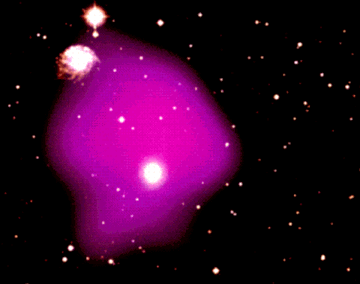 Apr 6, 2011; 9:06 PM ET
Apr 6, 2011; 9:06 PM ET
A fan of AccuWeather Astronomy on facebook mentioned a TV show they watched about dark matter. This subject is very interesting and since I did not know much about it, I did some research on what it is and decided to share it with you.
Dark matter is the name given to the amount of mass whose existence is deduced from the analysis of galaxy rotation curves which they had no explanation for. Even though we do not see dark matter directly, its gravitational influence can be seen in the motion of gas and stars in galaxies, and also in the motion of hot gas and galaxies within clusters of galaxies.
There are many theories on what dark matter could be. At the moment there is not a convincing enough answer and the question is still a mystery.
Astronomers know that the mass needed to cause the motions is out there. This mass in turn leads to the gravity needed to cause these motions. Remarkably, it turns out there must be at least five times more mass in clusters of galaxies than we see. Since we can not see it, we assume it is dark and thus the term dark matter was coined by a Swiss astronomer named Fritz Zwicky in the 1930s.
In turns out that most of the stuff in clusters of galaxies must be invisible due to the amount of gravity needed to cause the previously unexplained motions. Astronomers then conclude that in fact most of the matter in the entire universe is invisible.
Just imagine then that what we see out there is just the tip of the iceberg. There must be so much out there that we do not even know is there.
An Overlay of an Optical Image of a Cluster of Galaxies
with an X-Ray Image of Hot Gas Lying Within the Cluster
Please join the AccuWeather.com Astronomy fanpage by clicking here. You can leave your comments there as well and be part of a community where discussions on this or any other astronomy subject take place. We have reached 1,300 likes on Facebook and with your help we will get to 2,000 soon. Tell your friends about this site and blog, and weigh in on some exciting issues. We encourage open discussion and will never criticize any idea, and no negative conversation will be allowed.
blogs Home >
From Accuweather.com
White Dwarfs May Have Habitable Planets Near Them–Mark Paquette
Mar 2011;
In an internet paper published on Tuesday in The Astrophysical Journal Letters, Eric Agol, a University of Washington associate professor of astronomy, states that it could be much easier to find habitable (in terms of life as we know it) planets near white dwarfs as compared to other places in the universe.
Agol stated, “If a planet is close enough to the (white dwarf) star, it could have a stable temperature long enough to have liquid water at the surface — if it has water at all — and that’s a big factor for habitability.”
We are obviously interested in life on other planets in the universe. I was overwhelmed by the amount of responses received on the AccuWeather Astronomy facebook fanpage when I asked about the possibility of alien life and personal experiences with UFO’s and/or aliens. I mentioned above in parentheses the phrase “life as we know it.” I write this because we generally assume that other life forms in the universe, if they are out there, have the same requirements as we do (ie. water, oxygen, “normal” temperatures) and are carbon-based life forms, like we are. Who is to say this is true, though?
Studies like these look for planets with similar conditions to Earth because we assume that non-earthly life forms need them. Who is to say that is correct? Who knows the “right” type of planet we should be looking for? I guess we start with planets like our own, and we go from there. We would have no clue where to look for life if we do not look for planets with similar conditions to Earth.
I guess my point is, fine, look for planets like ours out there in the universe. However, do not limit it just to those few planets! How do we know what is out there and what type of planet may be right for them? Who is to say that life on other planets is just like life on Earth? I, for one, think that life on other planets may be much different than life on our planet.
A planet would have to move very close to the white dwarf to be habitable simply because, assuming that the alien life forms need similar temperatures to the Earth, of the weak output of energy from a white dwarf. Planets would have to be perhaps 500,000 to 2 million miles from the white dwarf star. That is less than 1 percent of the distance from Earth to the sun (93 million miles) and quite a bit closer than Mercury is to the sun.
Mr. Agol added, “From the planet, the star would appear slightly larger than our Sun, because it is so close, and slightly more orange, but it would look very, very similar to our Sun.”
A survey of the 20,000 white dwarfs closest to Earth is being proposed by Mr. Agol. Even though it would have a huge expense in terms of effort and people-hours, it may be worthwhile.
Please join the AccuWeather.com Astronomy fanpage by clicking here. You can leave your comments there as well and be part of a community where discussions on this or any other astronomy subject take place. We are approaching 1,300 likes on Facebook, and with your help we will get to 2,000 soon. Tell your friends about this site and blog, and weigh in on some exciting issues. We encourage open discussion and will never criticize any idea, and no negative conversation will be allowed.
blogs Home >
Mark Paquette – accuweather.com
Immense Solar Flare to Cause Northern Lights Show, Interference with Communications
Immense Solar Flare to Cause Northern Lights Show, Interference with Communications
Feb 17, 2011; 1:38 AM ET
From Mark Paquette– Accuweather.com
The sun has been and continues to be extremely active, unleashing solar flares from a sunspot region that was barely visible last week. The sunspot has grown in size to more than 62,000 miles across, a width nearly eight times the width of our Earth.
A video about the solar flare from AccuWeather.com Meteorologist Mary Yoon can be seen by clicking here.
The first flare was categorized by the NOAA Space Weather Prediction Center in Colorado as a Class M6.6. Then on Monday, a more intense X2.2 occurred. This was the strongest flare reported in four years. These flares will ramp up the displays of northern lights for sky-watchers living in northern latitudes and lucky enough to have clear skies. Click here for a description of the classes of solar flares.
The M6.6 is described as “moderate” in intensity, and the X2.2 is described as a “major” event. The X2.2 is already causing disruptions to satellites and communications systems. NOAA’s prediction center has forecast the possibility of additional solar flares from the same sunspot region over the next two or three days.
AccuWeather Astronomy Fanpage (please join by clicking here) follower Mark Combellack said…
“(This is the) latest blurb from the space weather folks at NOAA… ‘This is the calm before the storm. Three CMEs (coronal mass ejections) are en route (and) all (will be) a part of the Radio Blackout events. The last of the three seems to be the fastest and may catch both of the forerunners about mid to late day tomorrow, February 17. Watch this space for updates on… the impending — G2, possibly periods of G3 — geomagnetic storming’.”
“So they seem to be thinking that there could be some strong geomagnetic storming coming up, so Aurora Fans keep your eyes on the skies. I will post here when and if things start getting interesting.”
This is from the National Weather Service office in Fairbanks, Alaska:
THE NATIONAL WEATHER SERVICE SPACE WEATHER PREDICTION CENTER IN BOULDER COLORADO ANNOUNCED A HIGH PROBABILITY OF A SIGNIFICANT GEOMAGNETIC STORM OCCURRING THURSDAY FEBRUARY 17 THROUGH SUNDAY, FEBRUARY 20.
GEOMAGNETIC STORMS USUALLY LAST 24 TO 48 HOURS… BUT SOME MAY LAST FOR MANY DAYS. GROUND TO AIR… SHIP TO SHORE… SHORTWAVE BROADCAST… AND AMATEUR RADIO ARE VULNERABLE TO DISRUPTION DURING GEOMAGNETIC STORMS. NAVIGATION SYSTEMS LIKE GPS CAN ALSO BE ADVERSELY AFFECTED. IMPACTS IN ALASKA COULD BE MODERATE WITH THIS EVENT.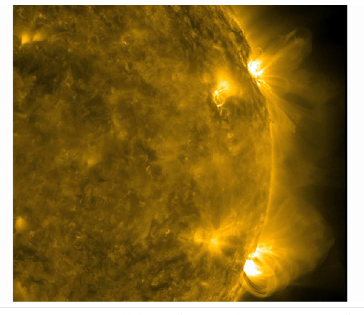
An image obtained Feb. 16, 2011 from NASA, shows a pair of active regions on the sun put on quite a show over a three-day period (Feb. 7-10, 2011) as seen in extreme ultraviolet light from the Solar Dynamic Observatory (SDO) spacecraft.
As mentioned above, with major flares there is the possibility of problems with radio communications after the eruption. The China Meteorological Administration is already reporting jammed shortwave radio communications. On March 10, 1989, a coronal mass ejection erupted from the sun and reached the Earth’s surface. The currents from this event entered some power grids and caused a power overload in Quebec, triggering a power outage for millions of Canadians that lasted for hours.
The United States is extremely vulnerable to coronal mass ejections for two reasons: (1) The high power grids that we use to transmit power would attract currents caused by coronal mass ejections and would ruin transformers. (2) We depend on power for things like sewage treatment, running water and many other life-supporting infrastructures. The loss of power for days or weeks could cause major problems for many Americans.
Parts of the northern United States and Britain may see the Northern lights Thursday night. According to the NY Daily News, “…for the United States, the most likely outcome from this latest space storm could be a colorful night sky over New England and even parts of New York State.”
Hopefully this solar event does not cause any major problems but it is definitely something to watch.
For the United States, New England and even parts of New York State look to have the best chance for a northern lights show. However, NOAA downplayed the chances of a display somewhat this morning. Only time will tell I guess!
Earth could be getting a second sun, at least temporarily.
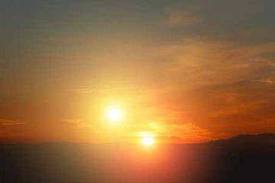 Wow , this is crazy stuff ,, very hard to believe one day soon — look up and see two suns
Wow , this is crazy stuff ,, very hard to believe one day soon — look up and see two suns
See detail below
—————————————————————
Dr. Brad Carter, Senior Lecturer of Physics at the University of Southern Queensland, outlined the scenario to news.com.au. Betelgeuse, one of the night sky’s brightest stars, is losing mass, indicating it is collapsing. It could run out of fuel and go super-nova at any time.
When that happens, for at least a few weeks, we’d see a second sun, Carter says. There may also be no night during that timeframe.
The Star Wars-esque scenario could happen by 2012, Carter says… or it could take longer. The explosion could also cause a neutron star or result in the formation of a black hole 1300 light years from Earth, reports news.com.au.
But doomsday sayers should be careful about speculation on this one. If the star does go super-nova, Earth will be showered with harmless particles, according to Carter. “They will flood through the Earth and bizarrely enough, even though the supernova we see visually will light up the night sky, 99 per cent of the energy in the supernova is released in these particles that will come through our bodies and through the Earth with absolutely no harm whatsoever,” he told news.com.au.
In fact, a neutrino shower could be beneficial to Earth. According to Carter this “star stuff” makes up the universe. “It literally makes things like gold, silver – all the heavy elements – even things like uranium….a star like Betelgeuse is instantly forming for us all sorts of heavy elements and atoms that our own Earth and our own bodies have from long past supernovi,” said Carter.
Solstice-eclipse overlap first in 456 years- From Montreal Gazette
BY REBECCA LINDELL, POSTMEDIA NEWS DECEMBER 16, 2010
This year’s winter solstice — an event that will occur next Tuesday — will coincide with a full lunar eclipse in a union that hasn’t been seen in 456 years.

This year’s winter solstice — an event that will occur next Tuesday — will coincide with a full lunar eclipse in a union that hasn’t been seen in 456 years.
The celestial eccentricity holds special significance for spiritualities that tap into the energy of the winter solstice, the shortest day of the year and a time that is associated with the rebirth of the sun.
“It’s a ritual of transformation from darkness into light,” says Nicole Cooper, a high priestess at Toronto’s Wiccan Church of Canada. “It’s the idea that when things seem really bleak, (it) is often our biggest opportunity for personal transformation.
“The idea that the sun and the moon are almost at their darkest at this point in time really only further goes to hammer that home.”
Cooper said Wiccans also see great significance in the unique coupling of the masculine energy of the sun and the feminine energy of the moon — transformative energies that she plans to incorporate into the church’s winter-solstice rituals.
Since the last time an eclipse and the winter solstice happened simultaneously was just under five centuries years ago, Cooper said she wasn’t familiar with any superstitions or mythologies associated with it.
Instead, she said, they can only be interpreted personally.
“Wiccans don’t think of things as being good or evil — they just are. Our experience of them makes them positive or negative for us.”
The winter solstice also played an important role in Greco-Roman rituals.
“It’s seen as a time of rebirth or renewal because, astrologically, it’s a time where the light comes back,” said Shane Hawkins, a professor of Greek and Roman studies at Carleton University in Ottawa.
For the ancient Romans, it was also a time of great feasting and debauchery.
“If (the eclipse) happened on the 21st, they might well have been drunk,” he said.
A lunar eclipse taking place during the solstice is not an event Hawkins has seen in research, but he said it would have been viewed as something special.
“Eclipses could be taken either way,” he said. “Certainly it would have been an omen, but it would have been up to the interpretation of specialists of whether it was good or bad.”
And that interpretation would likely be based on whatever was happening at the time.
The last time the two celestial events happened at the same time was in AD 1554, according to NASA.
An otherwise seemingly unexceptionable year in recorded history, the darkened moon happened during a bleak year for Tudor England.
Lady Jane Grey was beheaded for treason that year, while Princess Elizabeth was imprisoned in the Tower of London. Mary of Guise — the mother of Mary, Queen of Scots — became regent of Scotland.
Scientifically, however, it’s just a coincidence of natural cycles.
“It’s quite rare, but there’s no profound significance. It’s luck of the draw; you got dealt four aces,” said Robert Dick, an astronomy instructor at Carleton.
The eclipse will start just after midnight Eastern Time on Tuesday, with the main event starting at 1:30 a.m. ET and lasting until 5:30 a.m., when the moon reappears.
Read more: http://www.montrealgazette.com/life/Solstice+eclipse+overlap+first+years/3983582/story.html#ixzz18VCUcKFK
Space- News NASA's Fermi Telescope Finds Giant Structure in our Galaxy
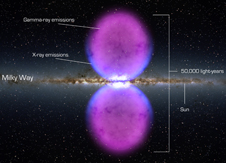 WASHINGTON — NASA’s Fermi Gamma-ray Space Telescope has unveiled a previously unseen structure centered in the Milky Way. The feature spans 50,000 light-years and may be the remnant of an eruption from a supersized black hole at the center of our galaxy.
WASHINGTON — NASA’s Fermi Gamma-ray Space Telescope has unveiled a previously unseen structure centered in the Milky Way. The feature spans 50,000 light-years and may be the remnant of an eruption from a supersized black hole at the center of our galaxy.
“What we see are two gamma-ray-emitting bubbles that extend 25,000 light-years north and south of the galactic center,” said Doug Finkbeiner, an astronomer at the Harvard-Smithsonian Center for Astrophysics in Cambridge, Mass., who first recognized the feature. “We don’t fully understand their nature or origin.”
The structure spans more than half of the visible sky, from the constellation Virgo to the constellation Grus, and it may be millions of years old. A paper about the findings has been accepted for publication in The Astrophysical Journal.
Finkbeiner and his team discovered the bubbles by processing publicly available data from Fermi’s Large Area Telescope (LAT). The LAT is the most sensitive and highest-resolution gamma-ray detector ever launched. Gamma rays are the highest-energy form of light.
Other astronomers studying gamma rays hadn’t detected the bubbles partly because of a fog of gamma rays that appears throughout the sky. The fog happens when particles moving near the speed of light interact with light and interstellar gas in the Milky Way. The LAT team constantly refines models to uncover new gamma-ray sources obscured by this so-called diffuse emission. By using various estimates of the fog, Finkbeiner and his colleagues were able to isolate it from the LAT data and unveil the giant bubbles.
Scientists now are conducting more analyses to better understand how the never-before-seen structure was formed. The bubble emissions are much more energetic than the gamma-ray fog seen elsewhere in the Milky Way. The bubbles also appear to have well-defined edges. The structure’s shape and emissions suggest it was formed as a result of a large and relatively rapid energy release – the source of which remains a mystery.
One possibility includes a particle jet from the supermassive black hole at the galactic center. In many other galaxies, astronomers see fast particle jets powered by matter falling toward a central black hole. While there is no evidence the Milky Way’s black hole has such a jet today, it may have in the past. The bubbles also may have formed as a result of gas outflows from a burst of star formation, perhaps the one that produced many massive star clusters in the Milky Way’s center several million years ago.
“In other galaxies, we see that starbursts can drive enormous gas outflows,” said David Spergel, a scientist at Princeton University in New Jersey. “Whatever the energy source behind these huge bubbles may be, it is connected to many deep questions in astrophysics.”
Hints of the bubbles appear in earlier spacecraft data. X-ray observations from the German-led Roentgen Satellite suggested subtle evidence for bubble edges close to the galactic center, or in the same orientation as the Milky Way. NASA’s Wilkinson Microwave Anisotropy Probe detected an excess of radio signals at the position of the gamma-ray bubbles.
The Fermi LAT team also revealed Tuesday the instrument’s best picture of the gamma-ray sky, the result of two years of data collection.
“Fermi scans the entire sky every three hours, and as the mission continues and our exposure deepens, we see the extreme universe in progressively greater detail,” said Julie McEnery, Fermi project scientist at NASA’s Goddard Space Flight Center in Greenbelt, Md.
NASA’s Fermi is an astrophysics and particle physics partnership, developed in collaboration with the U.S. Department of Energy, with important contributions from academic institutions and partners in France, Germany, Italy, Japan, Sweden and the United States.
“Since its launch in June 2008, Fermi repeatedly has proven itself to be a frontier facility, giving us new insights ranging from the nature of space-time to the first observations of a gamma-ray nova,” said Jon Morse, Astrophysics Division director at NASA Headquarters in Washington. “These latest discoveries continue to demonstrate Fermi’s outstanding performance.”

